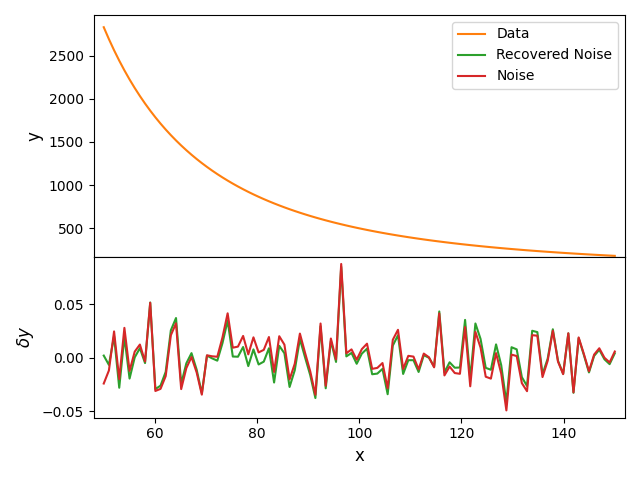maxsmooth:Derivative Constrained Function Fitting
Project description
- maxsmooth:
Derivative Constrained Function Fitting
- Version:
- 1.1.0
- Homepage:
- Documentation:





Derivative Constrained Functions and maxsmooth
maxsmooth is an open source software for fitting derivative constrained functions, DCFs such as Maximally Smooth Functions , MSFs to data sets. MSFs are functions for which there are no zero crossings in derivatives of order m >= 2 within the domain of interest. They are designed to prevent the loss of signals when fitting out dominant smooth foregrounds or large magnitude signals that mask signals of interest. Here “smooth” means that the foregrounds follow power law structures and do not feature turning points in the band of interest. In some cases DCFs can be used to highlight systematics in the data. More generally for DCFs the minimum constrained derivative order, m can take on any value or a set of specific high order derivatives can be constrained.
maxsmooth uses quadratic programming implemented with CVXOPT to fit data subject to a fixed linear constraint, Ga <= 0, where the product Ga is a matrix of derivatives. The constraint on an MSF are not explicitly linear and each constrained derivative can be positive or negative. maxsmooth is, however, designed to test the <= 0 constraint multiplied by a positive or negative sign. Where a positive sign in front of the mth order derivative forces the derivative to be negative for all x. For an Nth order polynomial maxsmooth can test every available sign combination but by default it implements a sign navigating algorithm. This is detailed in the maxsmooth paper (see citation), is summarized below and in the software documentation.
The available sign combinations act as discrete parameter spaces all with global minima and maxsmooth is capable of finding the minimum of these global minima by implementing a cascading algorithm which is followed by a directional exploration. The cascading routine typically finds an approximate to the global minimum and then the directional exploration is a complete search of the sign combinations in the neighbourhood of that minimum. The searched region is limited by factors that encapsulate enough of the neighbourhood to confidently return the global minimum.
The sign navigating method is reliant on the problem being “well defined” but this is not always the case and it is in these instances it is possible to run the code testing every available sign combination on the constrained derivatives. For a definition of a “well defined” problem and it’s counter part see the maxsmooth paper and the documentation.
maxsmooth features a built in library of DCFs or allows the user to define their own. The addition of possible inflection points and zero crossings in higher order derivatives is also available to the user. The software has been designed with these two applications in mind and is a simple interface.
Example Fit
Shown below is an example MSF fit performed with maxsmooth to data that follows a y = x-2.5 power law with a randomly generated Gaussian noise with a standard deviation 0.02. The top panel shows the data and the bottom panel shows the residual after subtraction of the MSF fit. The software using one of the built in DCF models and fitting normalised data is shown to be capable of recovering the random noise.

Installation
The software can be pip installed from the PYPI repository like so,
pip install maxsmoothor alternatively it can be installed from the git repository via,
git clone https://github.com/htjb/maxsmooth.git
cd maxsmooth
python setup.py install --userLicence and Citation
The software is free to use on the MIT open source license. However if you use the software for academic purposes we request that you cite the maxsmooth paper.
H. T. J. Bevins et al., maxsmooth: Rapid maximally smooth function fitting with applications in Global 21-cm cosmology, arXiv e-print, arXiv:2007.14970, 2020.
Below is the BibTex citation,
@ARTICLE{maxsmooth,
author = {{Bevins}, H.~T.~J. and {Handley}, W.~J. and {Fialkov}, A. and
{de Lera Acedo}, E. and {Greenhill}, L.~J. and {Price}, D.~C.},
title = "{maxsmooth: Rapid maximally smooth function fitting with applications in Global 21-cm cosmology}",
journal = {arXiv e-prints},
year = 2020,
month = jul,
eid = {arXiv:2007.14970},
pages = {arXiv:2007.14970},
archivePrefix = {arXiv},
eprint = {2007.14970},
primaryClass = {astro-ph.CO},
adsurl = {https://ui.adsabs.harvard.edu/abs/2020arXiv200714970B},
adsnote = {Provided by the SAO/NASA Astrophysics Data System}
}Documentation
The documentation is available at: https://maxsmooth.readthedocs.io/
Alternatively, it can be compiled locally from the git repository and requires sphinx to be installed. You can do this via:
cd docs/
make SOURCEDIR=source htmlor
cd docs/
make SOURCEDIR=source latexpdfThe resultant docs can be found in the docs/_build/html/ and docs/_build/latex/ respectively.
Requirements
To run the code you will need the following additional packages:
To compile the documentation locally you will need:
To run the test suit you will need:
Project details
Download files
Download the file for your platform. If you're not sure which to choose, learn more about installing packages.











